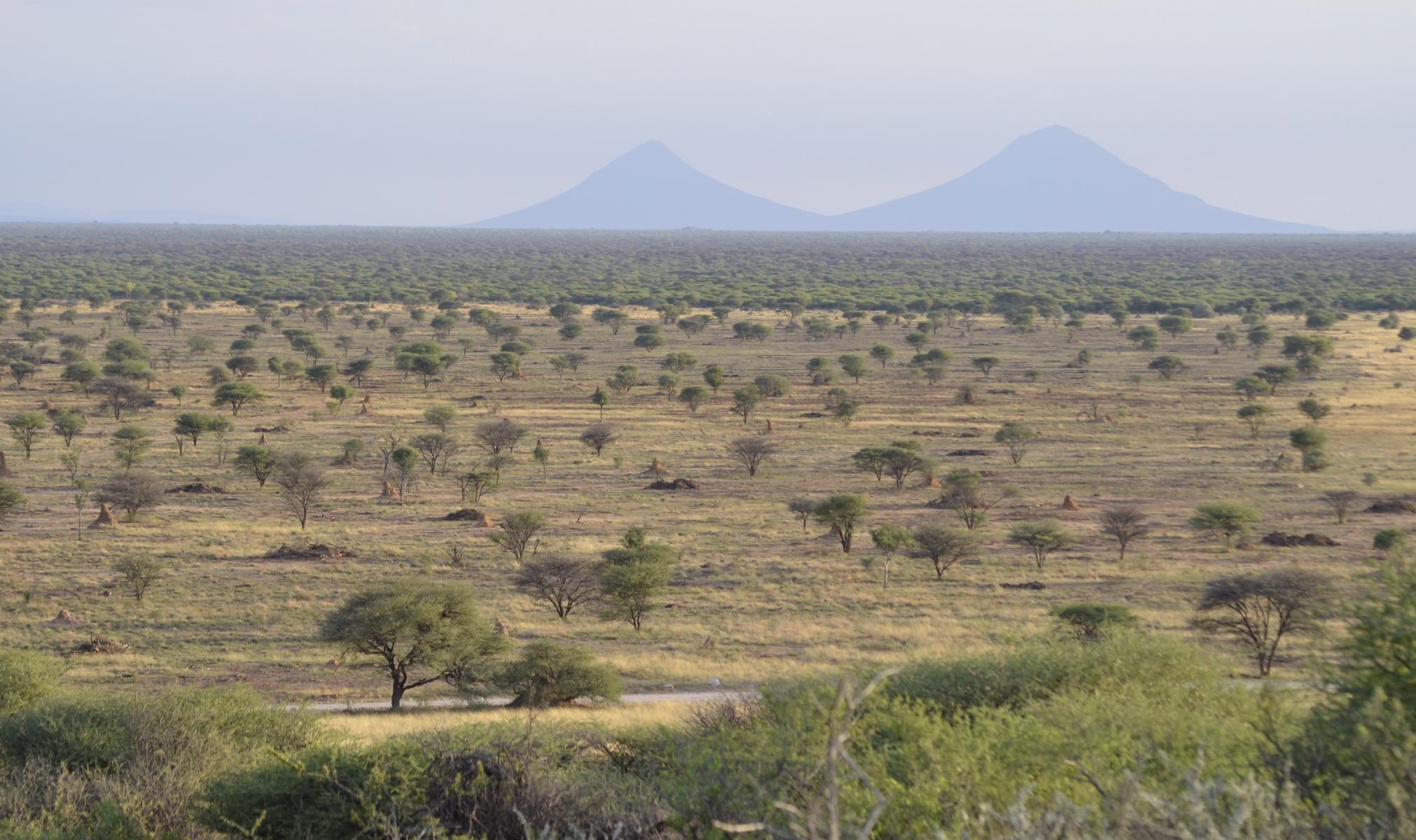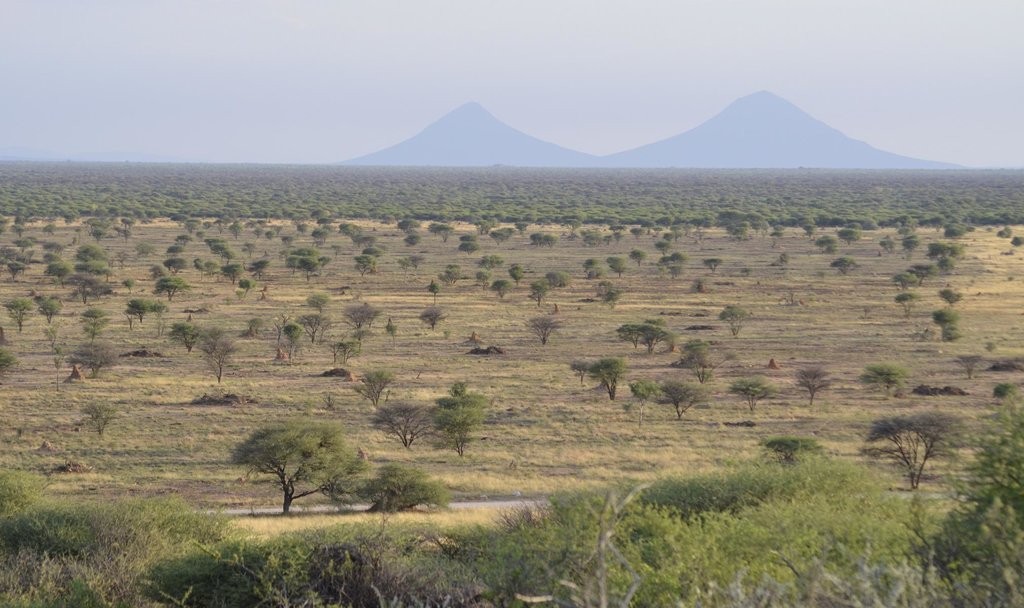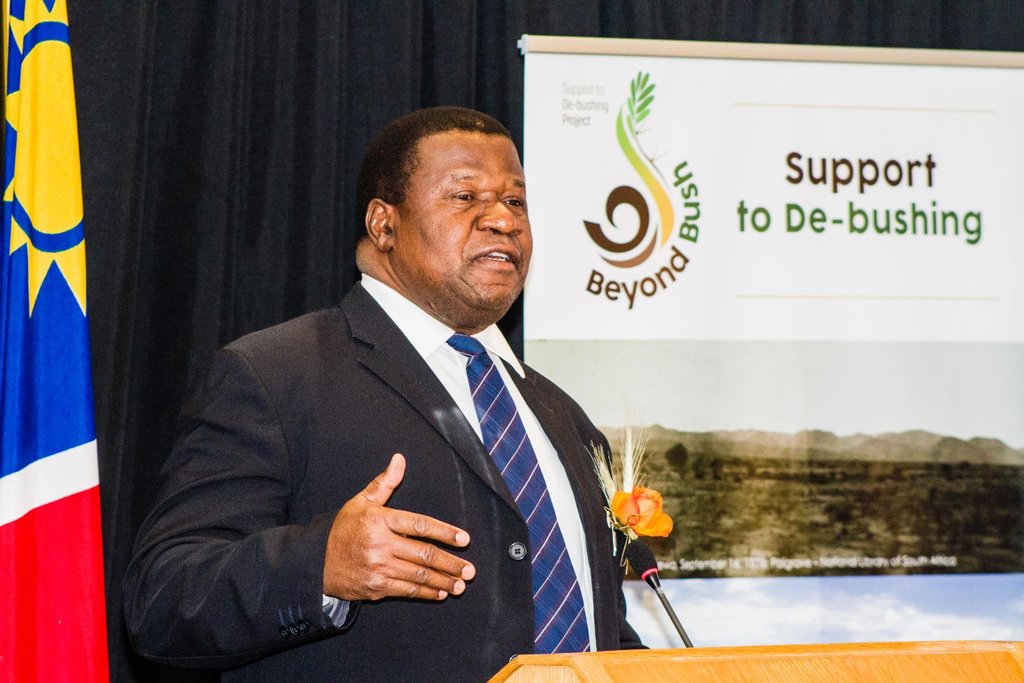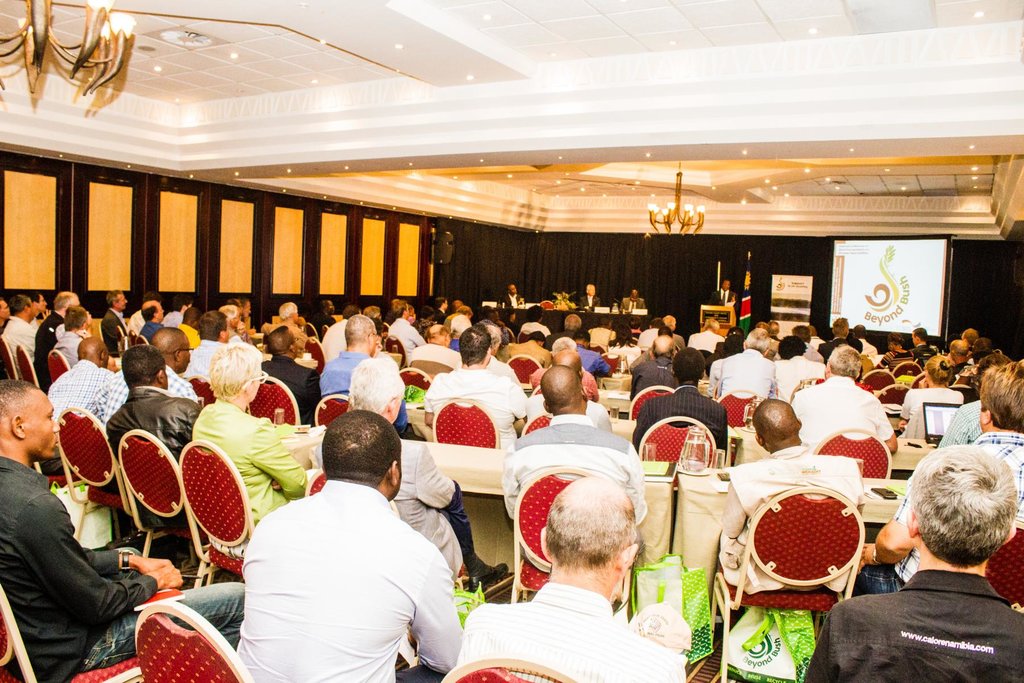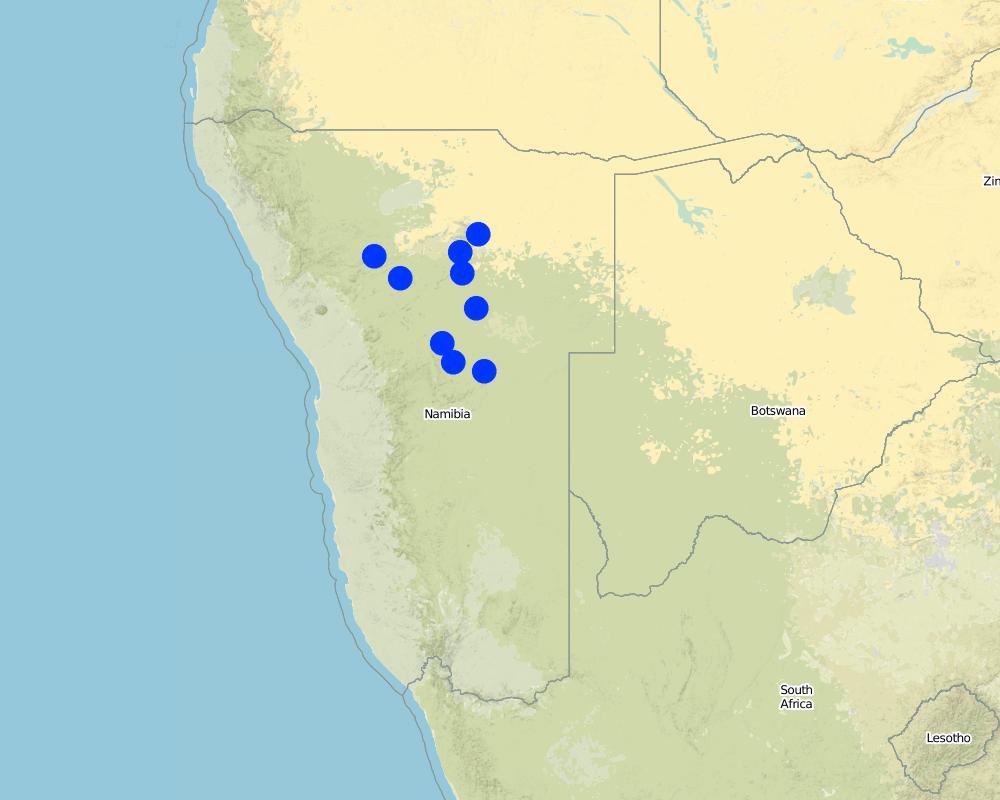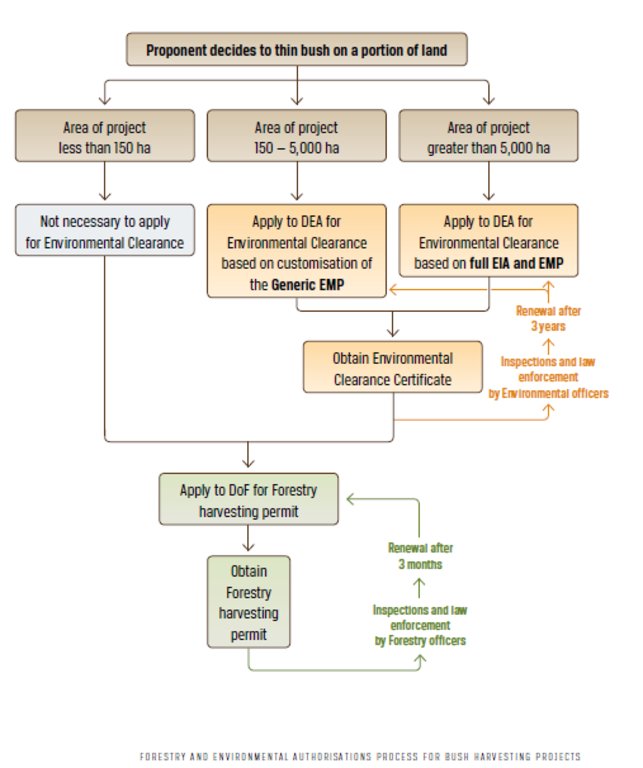Bush Control and Biomass Utilisation [ناميبيا]
- تاريخ الإنشاء:
- تحديث:
- جامع المعلومات: Johannes Laufs
- المحرر: –
- المُراجع: Rima Mekdaschi Studer
Bush Control and Biomass Utilisation
approaches_2809 - ناميبيا
عرض الأقسام
توسيع الكل طي الكل1. معلومات عامة
1.2 تفاصيل الاتصال بالأشخاص الرئيسيين لمصدر المعلومات والمؤسسات المعنية بتقييم وتوثيق النهج
اسم المؤسسة (المؤسسات) التي سهلت توثيق/تقييم النهج (إذا كان ذلك على صلة)
Deutsche Gesellschaft für Internationale Zusammenarbeit (GIZ) GmbH (GIZ) - ألمانيا1.3 الشروط المتعلقة باستخدام البيانات الموثقة من خلال WOCAT
متى تم تجميع البيانات (ميدانيا)؟:
01/06/2015
يوافق جامع المعلومات والشخص (لاشخاص) الرئيسي لمصدر المعلومات على الشروط المتعلقة باستخدام البيانات الموثقة من خلال WOCAT:
نعم
1.4 المراجع الخاصة باستبيان(استبيانات) تقنيات الإدارة المستدامة للأراضي
2. وصف نهج الإدارة المستدامة للأراضي
2.1 وصف موجز للنهج
Public and private stakeholders in Namibia cooperate in the implementation of a national Bush Control and Biomass Utilisation programme. The programme consists of the three components (1) Creation of an enabling framework, (2) Advisory Services and (3) Value Chain Development.
2.2 وصف تفصيلي للنهج
وصف تفصيلي للنهج:
Public and private stakeholders in Namibia cooperate in the implementation of a national Bush Control and Biomass Utilisation programme. It is a response to the immense challenge of bush encroachment in the country.
Namibia is affected by bush encroachment on a massive scale. The phenomenon currently affects some 45 million hectares of farmland in 9 of the country’s 14 regions. Bush encroachment has lowered the livestock capacity of rangeland by up to two thirds. It further results in severely reduced biodiversity and limits the recharge of groundwater.
Various factors contribute to the accelerating rate of bush encroachment in Namibia. A primary cause of bush encroachment of savannas is overgrazing by livestock. When overgrazed, the grass layer loses its competitive advantage and its ability to utilise nutrients and water efficiently. Higher infiltration of water and nutrients into the sub-soil results, which in turn benefits bush and tree species, allowing them to dominate.
Another important theory is the state-and-transition model, which states that savanna ecosystems are event-driven, where rainfall and its variability impact on vegetation growth and its composition. This model implies that bush encroachment is not a permanent phenomenon and that a savanna can be changed to its grass-dominated state by favourable management or environmental conditions. Woody plants establish themselves after dry periods followed by a few wet years, and then maintain themselves by utilising most of the water. Rather than a gradual annual increase in numbers, the general rule is that woody plants establish in large numbers during certain years and at varying intervals.
Other factors contributing to bush encroachment are the reduction in the frequency of wildfires as well as the absence of browsers (e.g. through fencing of farms and replacing the natural composition of wildlife by cattle or smallstock).
Bush encroachment is accompanied by a change in the dominant grasses: perennial grasses are often lost, being replaced by annual species often of inferior quality for livestock. Annual grasses are generally less productive than perennial grasses. Thus, animal production on an annual grass sward is very precarious and less sustainable.
Despite the negative impacts, the encroacher bush has developed into a huge biomass resource, estimated at about 200 to 300 million tonnes. Measures used to combat bush encroachment create positive opportunities for the Namibian economy, such as the use of the resource for electricity generation and value chain development in other sectors. Bush harvesting therefore offers the potential to increase agricultural productivity, economic growth, employment and energy security, without competing with food production.
In line with the national development plans, the approach aims to strengthen the restoration of productive rangeland in Namibia. It identifies value chain opportunities to trigger large-scale bush thinning activities. Its focus is closely aligned to the National Industrial Policy of 2012 and the Growth at Home Strategy, which promote domestic value addition for local resources. The project will foster institutional development in the biomass sector and provide support to improve the legal and regulatory framework for large-scale bush control.
The programme consists of the following three components:
(1) Creation of an enabling framework: harmonisation of sector policies and improvement of relevant regulations; strengthening of institutional capacities.
(2) Advisory Services: strengthening of existing farmer outreach services and knowledge dissemination to farmers, businesses and public sector decision makers.
(3) Value Chain Development: identification and piloting of relevant value chains for encroacher bush as a trigger for bush control.
The programme is implemented in collaboration of various public and private sector stakeholders. Its coordination is ensured through a cross-sector steering committee, which includes the line ministries of the following sectors: national planning, agriculture, environment, energy, industrialisation.
Key outputs of the programme include:
Enabling Environment:
- Strategic Environmental Assessment (SEA)
- Introduction of Harvesting Authorisations Guidelines
- Development of dedicated financial products (loan subsidy schemes).
Institutions:
- Introduction of the De-bushing Advisory Service (DAS)
- Introduction of the Namibia Biomass Industry Group (N-BiG).
Knowledge:
- Compilation of baseline data on bush encroachment and bush control
- Technical know how on technologies
- Compilation of relevant regulations and environmental principles.
Value Chain Development:
- Piloting of various value chains, including modernised charcoal production, bush based animal feed and household cooking fuel.
2.3 صور عن النهج
2.5 البلد/المنطقة/المواقع التي تم تطبيق النهج فيها
البلد:
ناميبيا
المنطقة/الولاية/المحافظة:
Bush control is applied across Namibia on many privately owned farms. Activities are most concentrated in the regions of Khomas, Omaheke, Otjozondjupa and Oshikoto.
مزيد من التفاصيل حول الموقع:
Pointers indicate hotspots (e.g. urban centres) around which activities are concentrated. It is not possible to depict each site where bush control is implemented due to the high number of individual activities and because no GIS based mapping has been conducted.
Map
×2.6 تواريخ بدء وإنهاء تنفيذ النهج
أشر إلى سنة البدء:
2014
في حالة عدم معرفة السنة بالتحديد، يرجى الإشارة إلى التاريخ التقريبي لبدء النهج:
منذ أقل من 10 سنوات (مؤخرًا)
سنة الإنهاء (إذا لم يعد النهج مطبقًا):
2021
2.7 نوع النهج
- قائم على مشروع/برنامج
2.8 الغايات/الأهداف الرئيسية للنهج
Develop, test and upscale the implementation of bush control technologies in Namibia.
2.9 الظروف التي تمكن أو تعيق تنفيذ التقنية/التقنيات المطبقة بموجب النهج
المعايير والقيم الاجتماعية /الثقافية/ الدينية
- تمكين/تمكيني
Strong awareness of the need to implement bush control across all stakeholder groups.
- معيق
Low level of cooperation and information exchange.
توفر/الوصول إلى الموارد والخدمات المالية
- معيق
Limited variety of dedicated/customised financial products available; cost of finance high.
الإطار المؤسساتي
- معيق
Low level of cross-sector coordination and limited funding sources for sector representative bodies (e.g. associations).
التعاون/التنسيق بين الجهات الفاعلة
- معيق
Low level of interaction and knowledge sharing.
الإطار القانوني (حيازة الأراضي، وحقوق استخدام الأراضي والمياه)
- تمكين/تمكيني
Clear land tenure in commercial areas and suitable concepts in communal areas (e.g. conservancies and community forests).
السياسات
- معيق
Low level of policy harmonisation across sectors; need to resolve conflicting mandates of relevant authorities (e.g. industrialisation vs. resource protection).
حوكمة الأراضي (صنع القرار والتنفيذ والإنفاذ)
- تمكين/تمكيني
Clear governance and management in commercial areas
- معيق
Unclear decision making processes for income generating projects in communal areas.
المعرفة حول الإدارة المستدامة للأراضي، والوصول إلى الدعم الفني
- معيق
Low level of bush control know how among land owners
الأسواق (لشراء المدخلات وبيع المنتجات) والأسعار
- تمكين/تمكيني
High national and international demand for woody products
عبء العمل، توفر القوى العاملة
- معيق
Low level of skills among workers
3. المشاركة وأدوار الأطراف المعنية
3.1 أصحاب المصلحة المعنيون بالنهج وأدوارهم
- مستخدمو الأراضي المحليون/المجتمعات المحلية
Commercial farmers, communal farmers
Implementation of bush control and/or availing land for bush control and biomass utilisation activities
- المنظمات المجتمعية
conservancies, community forests
Implementation of bush control and/or availing land for bush control and biomass utilisation activities
- متخصصون في الإدارة المستدامة للأراضي / مستشارون زراعيون
Farmer outreach services and independent experts
Dissemination of information and skills development
- الباحثون
Namibia University of Science (NUST), University of Namibia (UNAM)
Complementary research projects
- القطاع الخاص
Namibia Biomass Industry Group (N-BiG)
Representation of corporates involved in bush harvesting and biomass value addition.
- الحكومة الوطنية (المخططون، صانعو القرار)
National Planning Commission (NPC)
Ministry of Agriculture, Water and Forestry (MAWF)
Ministry of Environment and Tourism (MET)
Ministry of Mines and Energy (MME)
Ministry of Industrialisation and SME Development (MITSMED)
Policy and strategy development; sector steering; law enforcement, monitoring and evaluation.
- منظمة دولية
Deutsche Gesellschaft für Internationale Zusammmenarbeit (GIZ)
Implementation of bilateral cooperation project
3.2 انخراط مستخدمي الأراضي المحليين/المجتمعات المحلية في المراحل المختلفة للنهج
| انخراط مستخدمي الأراضي المحليين/المجتمعات المحلية | حدد من شارك وصف الأنشطة | |
|---|---|---|
| المبادرة/التحفيز | التعبئة الذاتية | High awareness and mobilisation within the farming community |
| التخطيط | تفاعلي | Good participation in public workshops and conferences |
| التنفيذ | التعبئة الذاتية | Implementation of bush control by individual farmers |
| الرصد/التقييم | سلبي | Very limited monitoring and evaluation through individual land owners |
3.3 مخطط التدفق (إذا كان متاحًا)
الوصف:
Legal and regulatory framework for large scale bush control: the flow chart explains the three levels of categories for the Environmental Clearance process. The categories are as follows:
- Small bush harvesting operations covering less than 150 ha: no environmental clearance required
- Medium bush harvesting operations covering between 150 and 5 000 ha: environmental clearance based on a generic Environmental Management Plan (EMP) is needed
- Large bush harvesting operations of more than 5 000 ha, Environmental Clearance based on Environmental Impact Assessment (EIA) and Environmental Management Plan (EMP)
Abbreviations:
DEA - Directorate of Environmental Affairs, Ministry of Environment and Tourism
DoF - Directorate of Forestry, Ministry of Agriculture, Water and Forestry
EIA - Environmental Impact Assessment
EMP - Environmental Management Plan
ha - hectares
المؤلف:
Southern African Institute for Environmental Assessment (2016)
3.4 اتخاذ القرار بشأن اختيار تقنية/تقنيات الإدارة المستدامة للأراضي
حدد من الذي قرر اختيار التقنية/التقنيات التي سيتم تنفيذها:
- جميع الجهات الفاعلة ذات الصلة، كجزء من نهج تشاركي
حدد على أي أساس تم اتخاذ القرارات:
- تقييم المعرفة الموثقة جيدًا بشأن الإدارة المستدامة للأراضي(اتخاذ القرارات القائمة على الأدلة)
- نتائج البحوث
- خبرة وآراء شخصية(غير موثقة)
4. الدعم الفني وبناء القدرات وإدارة المعرفة
4.1 بناء القدرات/التدريب
هل تم تقديم التدريب لمستخدمي الأراضي / الأطراف المعنيين الآخرين؟:
نعم
حدد من تم تدريبه:
- موظفون ميدانيون/ مستشارون
شكل التدريب:
- في العمل
- مناطق العرض
- اجتماعات عامة
المواضيع المغطاة:
- Environmental and forestry policy and policy emplementation (training for government officials from regional offices)
- Implementation of bush control and biomass processing (training for farmers and SMEs)
4.2 خدمة استشارية
هل يملك مستخدمو الأراضي وصولا إلى خدمة استشارية؟:
نعم
حدد ما إذا كانت الخدمة الاستشارية متوفرة:
- في مراكز دائمة
وصف/تعليقات:
Advisory services through the De-bushing Advisory Service (DAS, www.dasnamibia.org)
4.3 تعزيز المؤسسات (التطوير التنظيمي)
هل تم إنشاء أو تعزيز مؤسسات من خلال هذا النهج؟:
- نعم، إلى حد كبير
حدد المستوى (المستويات) التي تم فيها تعزيز أو إنشاء المؤسسات:
- وطني
صف المؤسسة والأدوار والمسؤوليات والأعضاء وما إلى ذلك.
Launch of
- De-bushing Advisory Service (DAS)
- Namibia Biomass Industry Group (N-BiG)
Re-organisation of
- Namibia Charcoal Association (NCA)
حدد نوع الدعم:
- مالي
- بناء القدرات/التدريب
- معدات
- Institutional Development
اعط مزيدا من التفاصيل:
Three sector institutions have been supported in order to achieve increased coordination of efforts. The Namibia Biomass Industry Group (N-BiG) is a non-profit association, representing the interest of bush harvesting and processing companies. The De-bushing Advisory Service (DAS) is a national platform for the dissemination of knowledge on the topics of bush encroachment, bush control and biomass utilisation.
The Namibia Charcoal Association (NCA) represents the already well established charcoal production sector. Through a re-organisation process, the association has been strengthended and turned into a fully functioning sector representation.
Thre three organisations are planned to merge in the near future in order to achieve a better alignment of their mandates and synergies of activities.
4.4 الرصد والتقييم
هل يشكل الرصد والتقييم جزءا من النهج؟:
نعم
التعليقات:
National Bush Information System
- Scope of bush encroachment
- Scope of bush control activities
- Success rate of bush control methodologies, incl. secondary impacts (employment)
إذا كانت الإجابة بنعم، فهل من المقصود استخدام هذه الوثائق للمراقبة والتقييم؟:
كلا
4.5 البحوث
هل كانت البحوث جزءًا من النهج؟:
نعم
حدد المواضيع:
- الاقتصاد / التسويق
- علم الايكولوجيا
- تكنولوجيا
أعط تفاصيل إضافية وأشر إلى من قام بالبحوث:
Collaboration with scientific institutions and networks on:
- Identification and development of suitable technology
- Correlation with ecosystem services, e.g. grounwater recharge and biodiversity
- Identification of market for bush based products
5. التمويل والدعم المادي الخارجي
5.1 الميزانية السنوية لمكون الإدارة المستدامة للأراضي في النهج المذكور
إذا لم تكن الميزانية السنوية الدقيقة معروفة، قم بالإشارة إلى نطاقها:
- > 1,000,000
التعليقات (على سبيل المثال المصادر الرئيسية للتمويل/الجهات المانحة الرئيسية):
Pooling of resources between national government, international donors and private sector
5.2 الدعم المالي/المادي المقدم لمستخدمي الأراضي
هل حصل مستخدمو الأراضي على دعم مالي/ مادي لتنفيذ التقنية/ التقنيات؟:
كلا
5.3 إعانات لمدخلات محددة (بما في ذلك العمالة)
- غير موجود
إذا كان العمل من قبل مستخدمي الأراضي مدخلاً جوهريًا، فهل كان:
- تطوعي
5.4 الائتمان
هل تم توفير ائتمان في إطار نهج أنشطة الإدارة المستدامة للأراضي؟:
نعم
حدد الشروط (معدل الفائدة، فترة السداد، الخ.):
Commercial loans with grace period of up to 3 years and interest rate of 7-8%
حدد مقدمي الائتمان:
Commercial banks: First National Bank (FNB), Agribank
Development Bank of Namibia (DBN)
Environmental Investment Fund (EIF)
حدد متلقي الائتمان:
- Individual households/farmers
- Service providers/business
5.5 حوافز أو وسائل أخرى
هل تم استخدام حوافز أو أدوات أخرى لتشجيع تنفيذ تقنيات الإدارة المستدامة للأراضي؟:
نعم
إذا كانت الإجابة بنعم، حدد:
Development of authorisations guidelines and review of regulations with regard to Environmental Management Plans (EMPs) and Environmental Impact Assessments (EIAs).
6. تحليل الأثر والتصريحات الختامية
6.1 آثار النهج
هل ساهم النهج في تمكين مستخدمي الأراضي المحليين وتحسين مشاركة الأطراف المعنية؟:
- لا
- نعم، قليلا
- نعم، باعتدال
- نعم، إلى حد كبير
Increased dissemination of information and exchange between land users on experiences with technologies; stakeholder representation through associations and participation in high level national conferences.
هل مكّن النهج من اتخاذ القرارات المبنية على الأدلة؟:
- لا
- نعم، قليلا
- نعم، باعتدال
- نعم، إلى حد كبير
Various publications to capture best practices in bush control and biomass utilisation, including farmers manuals.
هل ساعد النهج مستخدمي الأراضي على تنفيذ وصيانة تقنيات الإدارة المستدامة للأراضي؟:
- لا
- نعم، قليلا
- نعم، باعتدال
- نعم، إلى حد كبير
Development of various guidelines
هل نجح النهج في تحسين التنسيق والتنفيذ الفعال من حيث التكلفة لأنشطة الإدارة المستدامة للأراضي؟:
- لا
- نعم، قليلا
- نعم، باعتدال
- نعم، إلى حد كبير
Improvement of cross-sector collaboration through steering committee
هل نجح النهج في تعبئة/تحسين الوصول إلى الموارد المالية لتنفيذ الإدارة المستدامة للأراضي؟:
- لا
- نعم، قليلا
- نعم، باعتدال
- نعم، إلى حد كبير
Involvement of financial institutions with the aim to develop customised financial products.
هل أدى النهج إلى تحسين معرفة وقدرات مستخدمي الأراضي على تنفيذ الإدارة المستدامة للأراضي؟:
- لا
- نعم، قليلا
- نعم، باعتدال
- نعم، إلى حد كبير
Various publications to capture best practices in bush control and biomass utilisation, including farmers manuals.
هل أدى النهج إلى تحسين معرفة وقدرات الأطراف المعنية الأخرى؟:
- لا
- نعم، قليلا
- نعم، باعتدال
- نعم، إلى حد كبير
Increase awareness of the opportunity of the biomass resource among public sector stakeholders as well as within the business community.
هل ساهم النهج في بناء/تعزيز المؤسسات والتعاون بين الأطراف المعنية؟:
- لا
- نعم، قليلا
- نعم، باعتدال
- نعم، إلى حد كبير
Through introduction of steering committee, working groups as well as through the strengthening of sector representative bodies/associations.
هل ساهم النهج في تمكين الفئات المحرومة اجتماعيا واقتصاديا؟:
- لا
- نعم، قليلا
- نعم، باعتدال
- نعم، إلى حد كبير
Employment creation in bush control and biomass utilisation, e.g. in charcoal production
هل أدى النهج إلى تحسين المساواة بين الجنسين وتمكين النساء والفتيات؟:
- لا
- نعم، قليلا
- نعم، باعتدال
- نعم، إلى حد كبير
Promotion of dedicated employment opportunities for women, e.g. in charcoal packaging
هل أدى النهج إلى تحسين الوصول إلى المياه والصرف الصحي؟:
- لا
- نعم، قليلا
- نعم، باعتدال
- نعم، إلى حد كبير
Improved groundwater recharge in bush controlled areas. Research is ongoing and first results indicate a significantly improved infiltration of rainwater into the groundwater. The reduced number of bushes leads to reduced evapotranspiration.
هل أدى النهج إلى استخدام طاقة/ مصادر طاقة أكثر استدامة؟:
- لا
- نعم، قليلا
- نعم، باعتدال
- نعم، إلى حد كبير
First biomass energy projects launched (industrial heating) and in preparation (national grid electricity production).
هل أدى النهج إلى توفير فرص عمل ودخل؟:
- لا
- نعم، قليلا
- نعم، باعتدال
- نعم، إلى حد كبير
Employment in bush harvesting and processing, especially in charcoal production.
6.2 المحفز الرئيسي لقيام مستخدمي الأراضي بتنفيذ الإدارة المستدامة للأراضي
- زيادة الإنتاج
Need for bush control in order to increase carrying capacity of land.
- الحد من تدهور الأراضي
Rehabilitation of land through bush thinning.
6.3 استدامة أنشطة النهج
هل يمكن لمستخدمي الأراضي المحافظة على استدامة ما تم تنفيذه من خلال النهج (بدون دعم خارجي)؟:
- نعم
إذا كانت الإجابة بنعم، صف كيف:
Land users have the capacity to implement bush control, either with own means (mainly manual and semi-mechanised bush harvesting) or through the involvement of service providers (mainly fully mechanised bush harvesting for the supply of large-scale off-takers).
6.4 نقاط قوة/مزايا النهج
| نقاط القوة/ المزايا/ الفرص من وجهة نظر مستخدمي الأراضي |
|---|
| Financial viability of bush control through the introduction of value chains (as compared to mere removal of the biomass) |
| Improved access to information and know how |
| Improved advocacy/ communication with government authorities |
| نقاط القوة/ المزايا/ الفرص من وجهة نظر جامع المعلومات أو غيره من الاشخاص الرئيسيين لمصدر المعلومات |
|---|
| Mindshift among public and decision makers from focus on the challenge (bush encroachment) to the opportunities (value addition). |
| Cross-sector cooperation through steering committee |
| Involvement of private sector as driving force for implementation |
6.5 نقاط الضعف/ العيوب في المنهج وطرق التغلب عليها
| نقاط الضعف/ المساوىء/ المخاطر من وجهة نظر مستخدم الأراضي | كيف يمكن التغلب عليها؟ |
|---|---|
| Limited direct (financial) support | Introdution of incentive schemes |
| Limited opportunities in remote areas, i.e. when distance to biomass off-takers is too large | Further development of on-farm solutions (e.g. bush-to-feed) |
| نقاط الضعف/ المساوىء/ المخاطر من وجهة نظر جامع المعلومات أو غيره من الاشخاص الرئيسيين لمصدر المعلومات | كيف يمكن التغلب عليها؟ |
|---|---|
| Complex programme steering requirements, due to multi-sector relevance. The national programme for Bush control and Biomass Utilisation is currently anchored in the Directorate of Forestry (DoF) of the Ministry of Agriculture. This adequately accounts for the fact that the bush resource is part of the national forestry/biomass resource and its utilisation must be regulated as such. However, this anchoring does not allow for an effective promotion of biomass utilisation (e.g. SME promotion, industrialisation concepts, development of logistics hubs) and innovative end-uses (e.g. development of biomass power plants). For this purpose other line ministries, such as Ministry of Mines and Energy (MME) as well as Ministry of Industrialisation and SME Development (MITSMED) are part of the programme's steering committee. | Establishment of national coordinating body to formalise the current steering committee |
7. المراجع والروابط
7.1 طرق جمع/مصادر المعلومات
- مقابلات مع مستخدمي الأراضي
- مقابلات مع المتخصصين/الخبراء في الإدارة المستدامة للأراضي
7.2 المراجع للمنشورات المتاحة
العنوان، المؤلف، السنة، النظام القياسي الدولي لترقيم الكتب ISBN:
Baseline Assessment for De-bushing Programme in Namibia (2014)
متاح من أين؟كم التكلفة؟:
GIZ Support to De-bushing Project, www.dasnamibia.org/downloads
7.3 روابط للمعلومات ذات الصلة المتوفرة على الإنترنت
العنوان/الوصف:
De-bushing Advisory Service (DAS) Namibia, Resource Section
عنوان الرابط URL:
www.dasnamibia.org/downloads
العنوان/الوصف:
Namibia Biomass Industry Group (N-BiG)
عنوان الرابط URL:
www.n-big.org
الروابط والوحدات المواضيعية
توسيع الكل طي الكلالروابط
لا يوجد روابط
الوحدات المواضيعية
لا يوجد وحدات مواضيعية


